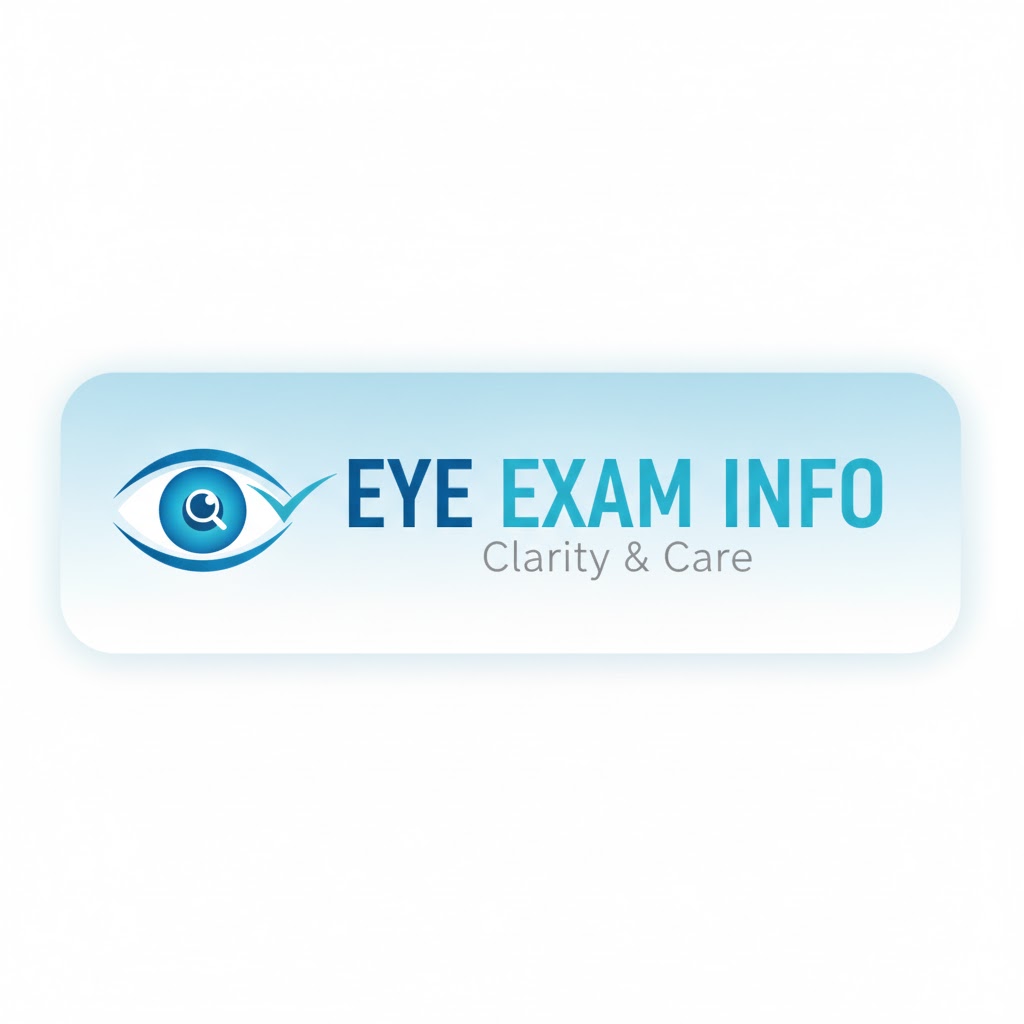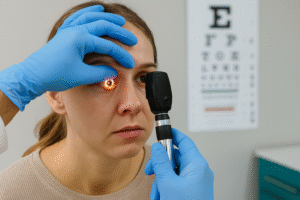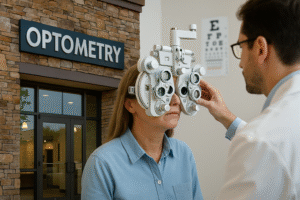Autorefractor Eye Exam: How It Works and Why It’s the Future of Vision Testing (2025 Guide)


Eye exams are evolving — and one of the biggest advancements in modern optometry is the autorefractor eye exam.
If you’ve ever sat in front of a machine that flashes lights and asks you to stare at an image of a hot-air balloon or a barn, you’ve already experienced it.
But what exactly does this test do?
Is it accurate enough to replace a manual refraction by an optometrist?
And how does it fit into a full vision exam for you or your kids?
Let’s break it down. 👇
What Is an Autorefractor Eye Exam?
An autorefractor eye exam is a quick, non-invasive test that automatically measures how light changes as it enters your eye.
It helps determine your prescription for glasses or contact lenses — without you having to guess “1 or 2?” multiple times.
How It Works
The machine (called an autorefractor) sends a beam of light into your eye and measures how it reflects off the retina.
It calculates:
- The curvature of your cornea
- The length of your eye
- The way light focuses on your retina
These measurements give optometrists an instant estimate of your refractive error — whether you’re nearsighted, farsighted, or have astigmatism.
💡 Fun fact:
Modern autorefractors take readings in under 5 seconds per eye — and are up to 98% accurate when verified by an optometrist.
Why Autorefractors Are Changing Eye Exams
Traditional refraction (the “better 1 or 2?” test) relies on subjective feedback — which can be inaccurate if you’re tired, distracted, or a child who doesn’t understand instructions.
Autorefractors eliminate the guesswork.
✅ Key Benefits:
| Feature | Advantage |
|---|---|
| Speed | Test takes less than 1 minute. |
| Accuracy | Highly reliable for initial prescriptions. |
| Comfort | Non-invasive, no air puffs or drops. |
| Kid-Friendly | Ideal for children or non-verbal patients. |
| Automation | Reduces human error in refraction measurements. |
👩⚕️ Many clinics now combine autorefractor + manual fine-tuning to create a “hybrid eye exam” that’s faster and more precise than ever.
Pediatric Use: Autorefractors for Kids
For parents searching “eye exam near me pediatric” — good news:
Autorefractors are child-safe and increasingly used in pediatric vision screenings.
They’re particularly helpful for:
- Kids who can’t read yet
- Autistic or non-verbal children
- Detecting early refractive errors before school age
💬 According to the American Academy of Ophthalmology, early use of autorefractors can help identify amblyopia (lazy eye) before it becomes permanent.
Types of Autorefractor Machines
Modern optometry clinics use several types of autorefractors.
| Type | Description | Use Case |
|---|---|---|
| Tabletop Autorefractor | The classic device used in most clinics. | Standard eye exams. |
| Handheld Autorefractor | Portable, used in schools or pediatric screenings. | Field exams, kids. |
| Autorefractor-Keratometer Combo | Measures both refraction and corneal curvature. | Contact lens fittings. |
| Wavefront Autorefractor | Uses advanced optics to detect micro aberrations. | LASIK pre-tests and precision exams. |
Autorefractor Eye Exam Cost in the U.S.
| Provider Type | Average Price | Notes |
|---|---|---|
| Retail Vision Centers (Walmart, Costco) | $45–$75 | Quick autorefractor-only tests |
| Optometry Clinics | $75–$125 | Includes doctor evaluation |
| Ophthalmologist Offices | $125–$200 | Often includes dilation and retina check |
💡 Tip:
At EyeExamInfo.com, you can filter clinics that use latest-generation autorefractors — ensuring both speed and accuracy in your vision check.
How Accurate Is an Autorefractor Eye Exam?
Autorefractors are extremely accurate for initial measurements, but…
They don’t replace a doctor’s clinical judgment.
Optometrists use autorefractor results as a starting point for manual refinement.
In most cases, the final prescription differs by 0.25 diopters or less.
In short: autorefractors are like autopilot — fast, smart, but always verified by a human expert. ✈️👓
When Should You Get an Autorefractor Eye Exam?
Consider scheduling one if:
- You haven’t had an eye exam in 12–18 months
- You’ve noticed blurred vision or headaches
- You’re buying new glasses or contacts
- You need a baseline before LASIK surgery
- Your child is struggling to read or focus
Autorefractor Eye Exam – FAQ
Is an autorefractor eye exam safe?
Yes, it’s completely safe — no radiation, pain, or drops are used.
Can it detect eye diseases?
It measures vision errors but not diseases. However, abnormalities may lead to further tests.
Can it replace a full exam?
Not entirely. It’s part of a complete eye exam but not a standalone diagnosis tool.
Is it accurate for kids?
Yes, modern autorefractors are designed for pediatric patients.
Does insurance cover it?
Usually yes, if part of a comprehensive eye exam.




Leave a Comment
Your comment will be published after it has been approved. Please send comments that do not contain slang words.